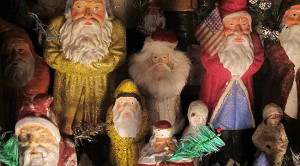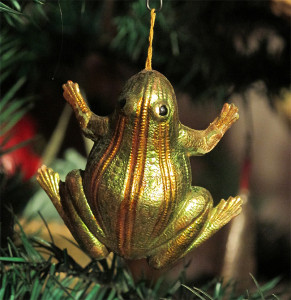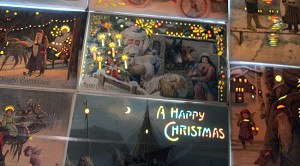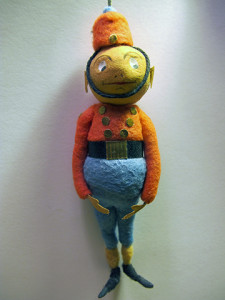A Seasonal Obsession: Collecting Christmas Past

Every major holiday I try to visit Darla’s home east of Cleveland. Halloween, Valentine’s Day, Easter—the artistic family’s rotating vintage display of seasonal décor never fails to delight. But it is Christmas that’s the real treat. From the front entryway to the restroom, krampuses, belsnickels, feather trees and snow babies fill every corner. Each year, I share this seasonal assault on the senses with a new group of friends. This year I am sharing just a little taste of Darla’s obsession and her impressive collection with you.
How long have you been collecting?
Over 40 years.
How did you get started?
When I was 18, I went to the Western Reserve Historical Society and I saw their tree. It was December. I thought it was just beautiful. At that time, I didn’t know how I’d ever get antique ornaments. I mean, these were in a museum—how did a person get things like that? Of course, I soon figured out you could find them at estate sales and secondhand stores. Once I knew that, I was off.
When you started collecting, not as many people thought these ornaments were valuable.
Dealers used to collect them, but they didn’t sell them. They collected for themselves because there was no money to be made. Now it’s very hard to find many of these ornaments and very expensive to buy them. I couldn’t amass a collection of this size if I started all over today because it would cost too much.
How many pieces do you have?
I really don’t have a clue. We have 20 trees up this year. Of course they can be twelve inches or eight feet high, but as long as they have ornaments on them, I count them as decorated trees.
How long does it take to put up your display every year?
This year it took about three weeks, I think.
 What era do you collect?
What era do you collect?
My favorite era to collect is the early 1900s. Ornaments then were a cottage industry and you can see the hand-painting and craftsmanship. These decorations weren’t produced in a factory. They were made in a home and the family members all worked on them.
I have to say, some of the ornaments you have are a bit frightening considering it is Christmas.
The subject matter is always the appeal for me. The more unusual things—the types of ornaments you’re referring to—are the ones that collectors are most excited about. Before there was Hallmark and American Greetings, people created ornaments that reflected their interests. The Germans were interested in creatures and spirits in the woods and so sometimes you see that expressed in their designs.
When did Christmas become more homogenized?
After World War II. Corning was making glass ornaments on a machine by then. Glass ornaments weren’t mouth-blown any more. There were just these people painting stripes on them. To me, that uniformity is not too interesting when I can find a handmade piece that has, say, a women’s face on one side and a flower on the back.
So is the attraction for you seasonal merriment or the artistic nature of the pieces?
I think it’s more about the objects themselves. The artistry is great. Aesthetically, I really enjoy them. And I get to put them together in different ways for display.
How do these intricate pieces made of thin glass or paper last a century or more?
You are only the caretaker of these things for a while. You have to do a good job of that. These ornaments were passed down through generations. They are so fragile. The only way they could have survived was because they were so cherished.
What an interesting story you have about a find?
There was the time we found our first Dresden ornament. Dresdens are some of the rarest ornaments. They’re embossed cardboard and are often assembled from many parts. They’re so detailed they look like metal and the range of subject matter they cover is enormous. Even when they were made originally they were expensive. We went to this estate sale and the first day we were there we saw these coaches in a box and thought they were made of metal. The last day of the sale, we decided to go back. We got a chance to look at them more closely and could see they were indeed of cardboard and they were Dresdens. We were buying some other things and asked if they’d take $20 for it all. They said, “Yes, we think those are overpriced anyway.” Those pieces today are worth around $1800 each.
 What else do you collect for Christmas?
What else do you collect for Christmas?
Along with photos of family Christmases, we have stereo views, old Christmas cards, nativities that fold out with several layers of depth, and hold to light postcards. Hold to light postcards have little cutout areas that you can’t really see without light pouring through. But when you hold, say, an image of a decorated tree up suddenly the lights will be colorfully lit by the effect.
You also have stockings, right?
Right. In the late 1880s they printed stockings on cotton fabric. You would cut out the pattern and sew it up and that would be your stocking. I have one that’s uncut [and framed].
Talk about a few of other ornament types.
We have a tree of end-of-day ornaments. At the end of the day, whatever paint they had left they would use on the ornaments. It’s a free-form type of a brush stroke. But they are rather beautiful, especially if you have a whole tree with these on along with some art glass pieces. In the 1920s in Germany they did art glass free blown pieces—they didn’t use molds—and really showed their craftsmanship with glass. They used striped tube of glass and blew the ornaments. So it’s not paint on the ornament, it’s the colors in the glass. Then there’s what’s called figural glass ornaments which are blown into molds. They can come in a wide range of subject matter and the glass is very, very thin. It’s almost like tissue paper. Those are so fragile they can even just disintegrate. Oh, and there are wire wrap ornaments. Those are truly Victorian. They made glass ornaments in rather garish colors which have since faded. They wrapped them in bright gold crinkle wire wrap, which tarnishes with age. Today these ornaments don’t look bright and gaudy like they once did; they have a mellow patina to them now. A lot of them focus on what Victorians were interested in in the 1890s, which were things like hot air balloons, dirigibles and biplanes.
Your husband also collects. How did you both get into this to share a passion?
I think it got interesting to him when the prices started going up. He may disagree with that. But that’s when we had to make sure we knew the definitive value of the collectibles. If you’re thinking about buying a $60 or $75 item, you better know if a piece is worth that. Value has a lot to do with rarity and condition.
Jerry restores ornaments too.
He does a great job. He can match color perfectly. And he never overdoes the restoration. A restoration should be the minimum you need to keep that piece. He feels that he is preserving that piece for future, which is really important to him.
Does it hurt the value of the piece at all?
No. If it is a well-done restoration, Christmas collectors don’t have a problem with that.
 Talk about the ornaments that you make.
Talk about the ornaments that you make.
They are cotton ornaments. You wrap the cotton around a wire armature. This was done in Germany in the late 1800s and early 1900s. When you find a good one now—well, I recently saw on eBay they were selling a couple of these cotton ornaments that were very nice and very old and they went for more than $900 apiece. We decided we could make something very similar, but not copy it. We wanted to bring our ideas to it. It has been six years or more that we’ve done this very successfully.
Is the idea that a collector could round out a historically decorated tree with your ornaments?
Yes. They fit in. We use all the old materials we can find to make them too. The crepe paper, the Victorian scraps and other parts are vintage.
Do you have your stuff on display anywhere?
This year we only have a display of the miniatures in our collection at the Shaker Historical Museum in Shaker Heights, Ohio. We have a miniature German-made toy store from around 1900. We put all antique miniatures in the store.
Is there ever going to be a time when enough is enough?
[Laughs.] If it ever comes to the point when I can’t physically put it out, I won’t keep it. But for now it’s fun. It’s a bit like creating magic and I like the way it brings people together.
Please specify a Flickr ID for this gallery
Take a look at some of last year’s display in this Flickr photo tour.













